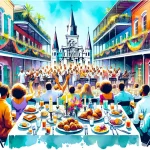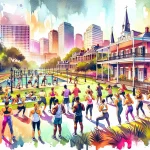Located in Louisiana, New Orleans comes to life during the annual Mardi Gras celebration, with Fat Tuesday being the peak of this festive season. This joyous event draws visitors worldwide to experience the vibrant energy of the Big Easy.
In This Article
TL;DR
- Fat Tuesday, or Mardi Gras Day, marks the final day of indulgence before the Lenten season begins in the Christian calendar.
- Elaborate parades featuring stunning floats and costumes by various krewes (social organizations) form the backbone of the celebrations.
- Jazz music and mouthwatering local cuisine like gumbo, jambalaya, and king cakes are integral parts of the Fat Tuesday experience.
Historical and Cultural Significance
The origins of Mardi Gras in New Orleans date back to the late 17th century when French-Canadian explorer Pierre Le Moyne d’Iberville and his crew landed near present-day New Orleans on March 3, 1699. They christened the location “Point du Mardi Gras” and held a small celebration, planting the seeds for future festivities.
As the city grew, so did the Mardi Gras traditions, absorbing influences from French, African, and other cultures that made up the diverse tapestry of New Orleans. The first recorded Mardi Gras parade took place in 1837, organized by the Mistick Krewe of Comus, and by the late 19th century, the celebration had evolved into a grand spectacle that attracted visitors from far and wide.
Fat Tuesday holds significant meaning in the Christian liturgical calendar, as it marks the last day before the start of Lent, a 40-day period of fasting and reflection. The name “Fat Tuesday” itself refers to the practice of consuming rich, fatty foods before the austere Lenten season begins.
Parades and Krewes
Rex
Among the most iconic krewes is Rex, founded in 1872, which is responsible for selecting the annual King of Carnival and introducing the official Mardi Gras colors of purple (justice), green (faith), and gold (power).
Zulu Social Aid and Pleasure Club
The Zulu Social Aid and Pleasure Club, known for its African-inspired costumes and hand-decorated coconuts, is another beloved krewe that has been parading since 1909.
Behind the scenes, artists and craftspeople work tirelessly to create the stunning floats and costumes that define the visual spectacle of Fat Tuesday. Each year, krewes select new themes and designs, ensuring that no two Mardi Gras celebrations are ever the same.
Music and Entertainment
Music is the heartbeat of Fat Tuesday in New Orleans, with the sounds of jazz, brass bands, and second-line parades filling the air from dawn until dusk. Street performers and marching bands add to the festive atmosphere, while legendary music venues like Preservation Hall and Tipitina’s showcase the city’s rich musical heritage.
The influence of New Orleans’ music legends, such as Louis Armstrong, Sidney Bechet, and Fats Domino, can be felt throughout the Fat Tuesday celebrations, as their contributions have shaped the city’s distinct musical identity. Many local musicians perform special Mardi Gras-themed shows and parades, adding to the joyous soundtrack of the day.
Culinary Traditions
No Fat Tuesday celebration in New Orleans would be complete without indulging in the city’s iconic culinary delights. From savory gumbo and jambalaya to sweet beignets and king cakes, the flavors of Mardi Gras are as diverse and vibrant as the city itself.
The king cake, a colorful pastry decorated in the traditional Mardi Gras colors, is a staple of the season. Hidden inside each cake is a small plastic baby figurine, and tradition dictates that whoever finds the baby in their slice must host the next king cake party. Popular bakeries like Gambino’s Bakery (4821 Veterans Memorial Blvd, Metairie, LA 70006) and Haydel’s Bakery (4037 Jefferson Hwy, Jefferson, LA 70121) offer a wide variety of king cakes, with flavors ranging from traditional cinnamon to decadent cream cheese and praline.
For a taste of classic New Orleans cuisine, head to renowned restaurants like Dooky Chase’s Restaurant (2301 Orleans Ave, New Orleans, LA 70119) or Galatoire’s (209 Bourbon St, New Orleans, LA 70130), where you can savor dishes like shrimp creole, red beans and rice, and oysters Rockefeller. Many local eateries also offer special Mardi Gras menus and cocktails, adding to the festive spirit of the day.
Participatory Events and Activities
One of the most exciting aspects of Fat Tuesday in New Orleans is the opportunity to fully immerse yourself in the celebrations. Dressing up in colorful costumes is a beloved tradition, with many visitors and locals alike donning elaborate masks, wigs, and outfits to join in the revelry.
To catch the famous Mardi Gras beads and other parade throws, it’s essential to know the lingo and techniques. Shout “Throw me something, mister!” to the float riders, and remember to bring a large bag to store your treasures. Be respectful of other parade-goers and always follow the instructions of local authorities to ensure a safe and enjoyable experience.
Beyond Bourbon Street
While the French Quarter is the epicenter of Fat Tuesday festivities, there are plenty of family-friendly options and local favorites to explore beyond the bustling heart of the city. The Uptown parade route along St. Charles Avenue offers a more laid-back atmosphere, with picturesque oak trees and historic mansions providing a stunning backdrop for the processions.
Neighborhood bars and venues also play a significant role in hosting alternative Mardi Gras events, catering to a diverse range of interests and age groups. The Marigny and Bywater neighborhoods, known for their vibrant arts scene and eclectic vibe, host numerous block parties and live music events throughout the day.
Moreover, Mardi Gras is not just about the parties and parades; it’s also a time for community engagement and charitable giving. Many krewes and organizations use the celebration as an opportunity to raise funds for local causes and support the city’s social fabric.
Planning Your Visit
If you’re planning to experience Fat Tuesday in New Orleans for the first time, there are a few key tips to keep in mind. Book your accommodations well in advance, as hotels and vacation rentals fill up quickly during Mardi Gras season. Consider staying in the French Quarter, Marigny, or Bywater neighborhoods to be close to the action.
To navigate the city during the festivities, familiarize yourself with the parade routes and schedules, and plan accordingly. Use public transportation or walk whenever possible, as parking can be scarce and traffic can be heavy. Don’t forget to pack comfortable shoes, sunscreen, and a reusable water bottle to stay hydrated throughout the day.
To truly experience Fat Tuesday like a local, venture beyond the tourist hotspots and seek out the hidden gems that make New Orleans so special. Strike up conversations with locals, sample the street food, and immerse yourself in the city’s rich history and culture. Remember to be respectful of local traditions and contribute positively to the community by supporting local businesses and artists.
As you celebrate Fat Tuesday in New Orleans, take a moment to appreciate the deep roots and cultural significance of this iconic event. From the elaborate parades and costumes to the mouthwatering cuisine and soulful music, Mardi Gras is a testament to the resilience, creativity, and joie de vivre of the people who call this city home. So grab your beads, put on your dancing shoes, and let the good times roll – it’s Fat Tuesday in New Orleans, and the party is just getting started!






